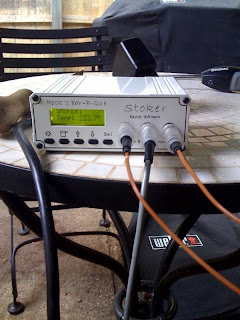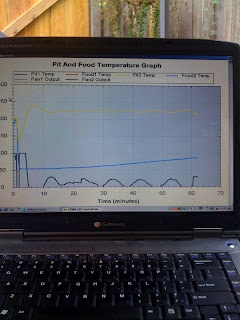
One of the big challenges in "low and slow" cooking is the amount of time and attention needed to produce a moist, smoky and tender beef brisket or pork shoulder. With cooking times of 15 hours (or more), it's essential to maintain a constant temperature (typically in the 220F-250F range) for a very long time. Although the Weber Smokey Mountain is quite capable of long burn times at the desired temperature range without a lot of input, it's still a good idea to pay semi-close attention to the temperature, fuel burn rate, etc. You can get up at dawn, start the smoker and watch it until dark, start cooking in the evening and stay up all night, or set the smoker and hope things stay steady while you're away doing something important, like sleeping.
There is an alternative, however. Currently, there are two producers of temperature control systems that use simple thermocouple temp probes, a blower fan, and a controller device that takes temperature readings and cycles the fan on and off to maintain a selected temperature inside the smoker. This allows near constant, low temperature cooking, a necessity when cooking cuts like beef brisket and pork shoulder. Here's how it works. Say you're cooking a brisket and you want a temperature of 220F inside your smoker and an internal meat temp of 190F. You program the controller with the desired temps, place one probe in the smoking chamber and stick the other probe in the meat. Then you fire up the smoker and put the lid on. As the charcoal begins to burn, the temperature of the smoker rises. The controller tells the fan to blow air on the coals until you reach the desired temperature. Once the desired temp is reached, the fan shuts off. After that the fan cycles on and off to maintain the desired temperature. Since the charcoal is in a semi-deprived oxygen state, it smolders rather than burning and lasts for quite a long time. The meat temp probe allows you to monitor the internal temp and pull the brisket off when you reach the desired temperature.
Yeah, I know, I know, you could watch the smoker continuously. Or you could trust it to stay steady. Or you could just go down to Harris Teeters or Rocklands for some ribs or pulled pork. But I really enjoy cooking my own BBQ, and my temp controller allows me to do just that and have time to do other things (like sleep, for example).
Full disclosure here; I have two temp controller systems. I'm attaching photos of both systems as well as a link to the manufacturers. I strongly suggest you check out the sites for a much more comprehensive explanation of the products and how they work. I'm not going to say which one I like better on the blog; however, I'm happy to answer any general questions on the differences between the two systems.
Stoker
The Stoker is manufactured by Rock's Bar-B-Que in Newark, CA. The Stoker controller actually generates an IP address, so you can link the controller to your local network and monitor/control the system via a computer or iPhone/BlackBerry. Quite handy if you prefer not to check the smoker status without having to go outside every time. Plus, since the Stoker is open architecture, there is at least one available freeware program out there that generates a detailed graph of smoker and meat temps and fan cycles over time. The Stoker's temp probe and fan plugs have color coded LEDs that light up. This is particularly helpful with the fan, as the blue LED comes on every time the fan receives power and you can see at a glance if the fan is cycling, running continuously or off.
http://rocksbarbque.com/
http://rocksbarbque.com/
Stoker system (fan is on lower left of the Weber Smokey Mountain)
Closeup of the Stoker Controller
Stoker Controller with Airport Express for network connectivity
BBQ Guru
The BBQ Guru Systems are manufactured in Warminster, PA. The company produces a full lineup of temperature control devices with varying features, specs and price. Unlike the Stoker, the BBQ Guru does not generate an IP address. It is, however, possible to run the system wirelessly via a USB wireless "hub and stick" system. The data can then be accessed via a computer within range of the USB hub (generally around 30 feet) or remotely via a remote program like MochaSoft. The BBQ Guru is a more "rugged" system, with steel braided temp probe cables and a water resistant controller. It does not have the LED equipped plugs like the Stoker.
BBQ Guru System (Fan on lower right of Weber)
Close up of the BBQ Guru Computer Graph (available via laptop/computer attached via USB or wireless USB)







Thanks for the information. I'm thinking about making the plunge with one of these. When you get a chance, would you mind replying (or emailing me) your recommendation on which you think would work best with a Weber kettle? Thank you.
ReplyDeleteIf you want a durable, extremely well-made system that is easy to operate and has superior customer service, then go with the BBQ Guru. They've got a wide range of systems, from super simple and bare bones to state of the art. Just give them a call and tell them what kind of kettle you've got and they can set you up with the appropriate adaptor and blower to meet your budget and needs.
ReplyDeleteIf you want a system that is internet ready and that you can view and control via your home computer, then maybe the Stoker is a good choice. Be aware, however, that the Stoker is not quite as rugged and is a good deal more "persnickety" in my experience. Plus my experience with Rock's BBQ (Stoker maker) customer service has been pretty unsatisfactory. Fine when things work well, but if you have a tech support question it's essential to able to talk to someone.
Regardless of who you go with, would you tell them you were referred from the Degüello BBQ blog? If you have more questions, please contact me at redc40@yahoo.com and I'd be happy to reply.